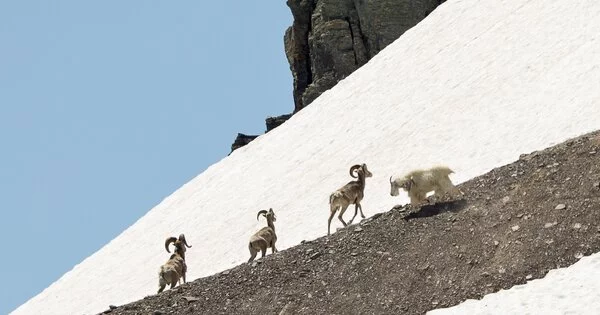A new study from the Wildlife Conservation Society (WCS), Colorado State University, and the National Park Service reveals previously unknown high-altitude competitions between two of America’s most spectacular mammals – mountain goats and bighorn sheep – for access to minerals that were previously unavailable due to the presence of glaciers, which are now vanishing due to global warming.
The study also highlights other coveted resources such as desert water and shade in harsh environments from Africa, Asia, and North America; species in these extreme environments compete for access to these biologically important resources, but such interactions have not previously been cataloged by individual species, size, or status as ‘native’ or ‘exotic.’
“While humans are rightly concerned about the climate-induced havoc we’re wreaking on the planet, much remains unknown about species aggression among our mammalian brethren,” said Joel Berger, lead author, and Senior Scientist for WCS and the Barbara Cox-Anthony Chair of Wildlife Conservation at Colorado State University.
While humans are rightly concerned about the climate-induced havoc we’re wreaking on the planet, much remains unknown about species aggression among our mammalian brethren.
Joel Berger
The findings of this study were distilled from fragmentary information dating back four decades and included species as diverse as marmots and baboons, oryx and elephants, and rhinos, as well as wild (i.e., feral) horses that displaced native pronghorn, mule deer, and elk from desert waters.
The study revealed that mountain goats with their saber-like horns emerged victorious over bighorn sheep in more than 98 percent of contests at three sites along a 900-mile gradient of above-treeline mountainous habitat from Colorado to Alberta, Canada. While mountain goats are a native species in northwestern North America, they are exotic in Colorado and Wyoming, including the Greater Yellowstone Ecosystem, where they were introduced.
Concerns there and elsewhere have focused on the extent to which goats may displace or outcompete native bighorns. Although it remains unknown if interactions to access resources have increased over time as our climate degrades, human activity has both increased and decreased access by wildlife to restricted resources such as minerals and water through road building and by the creation of artificial water sources.

The study appears in the journal Frontiers in Ecology and Evolution. Co-authors, Mark Biel, Chief biologist at Glacier National Park in Montana, and Ph.D. candidate Forest Hayes at CSU, pointed out that high elevation aggression between species, whether passive or active, highlights the importance of limited resources, but it’s been well known that both bighorns and mountain goats will travel up to fifteen miles or more to access these limited resources. Desert elephants travel distances even more impressive – up to 40 miles – to drink from distant waterholes in Namibia.
“It’s been exciting to gather data on goats and sheep in wind, snow, and cold on both Glacier and at Mt. Evans, Colorado, which reaches more than 14,000 feet,” Forest Hayes said, adding that “our observations both at close range and from distances of more than a mile provided unique opportunities for detecting and understanding ecological interactions.”
Berger, Biel, and Hayes suggest that climate change may play a role in groundwater depletion in desert areas, but they recognize that humans may be a more immediate threat because water use for people is increasingly jeopardizing the fragility of biodiversity in these systems. “If we can’t give other species a chance, we’re just cooking our fates along similarly destructive paths,” Berger said.
















